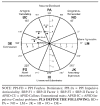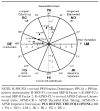Convergent and discriminant validity of psychopathy factors assessed via self-report: a comparison of three instruments
- PMID: 16123248
- PMCID: PMC2242351
- DOI: 10.1177/1073191105277110
Convergent and discriminant validity of psychopathy factors assessed via self-report: a comparison of three instruments
Abstract
Psychopathy has been conceptualized as a personality disorder with distinctive interpersonal-affective and behavioral deviance features. The authors examine correlates of the factors of the Psychopathic Personality Inventory (PPI), Self-Report Psychopathy-II (SRP-II) scale, and Antisocial Process Screening Device (APSD) to understand similarities and differences among the constructs embodied in these instruments. PPI Fearless Dominance and SRP-II Factor 1 were negatively related to most personality disorder symptoms and were both predicted by high Dominance and low Neuroticism. In addition, PPI Fearless Dominance correlated positively with antisocial personality features, although SRP-II Factor 1 did not. In contrast, PPI Impulsive Antisociality, SRP-II Factor 2, and both APSD factors correlated with antisocial personality features and symptoms of nearly all personality disorders, and were predicted by low Love. Results suggest ways in which the measurement of the constructs in each instrument may be improved.
Figures
References
-
- American Psychiatric Association. Diagnostic and statistical manual of mental disorders. 4. Washington, DC: Author; 1994.
-
- Benning SD. Fearlessness and underarousal in psychopathy: Startle blink modulation and electrodermal reactivity in a young adult male community sample. Unpublished master’s thesis. University of Minnesota; Minneapolis: 2004.
-
- Benning SD, Patrick CJ, Hicks BM, Blonigen DM, Krueger RF. Factor structure of the Psychopathic Personality Inventory: Validity and implications for clinical assessment. Psychological Assessment. 2003;15:340–350. - PubMed
-
- Brinkley CA, Schmitt WA, Smith SS, Newman JP. Construct validation of a self-report psychopathy scale: Does Levenson’s self-report psychopathy scale measure the same constructs as Hare’s psychopathy checklist-revised. Personality and Individual Differences. 2001;31:1021–1038.
Publication types
MeSH terms
Grants and funding
LinkOut - more resources
Full Text Sources



